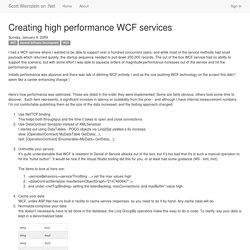

WCF P2P: How To Design State Sharing in a Peer Network. How To Design State Sharing In A Peer Network Kevin Hoffman In recent years, people have started to discover the amazing power and functionality that can be provided by an application that communicates over a peer network.

So-called peer applications cover the gamut from simple file sharing to instant messaging (IM) to full-on collaborative applications such as shared white boarding, Voice over IP (VoIP) calling and conferencing, social networking, and much more. Think about how your Xbox 360® automatically detects the presence of another computer running Windows Media® Center and can immediately begin sharing audio and video with that computer, allowing you to play music from your computer on your Xbox®. Wouldn't it be great if business applications sported the same kind of peer awareness and capability? This article is all about peer-enabling business applications by allowing them to share state in a serverless peer network. Fixed State Server Transient Elected State Server. Protobuf-net - Project Hosting on Google Code. Introduction protocol buffers is the name of the binary serialization format used by Google for much of their data communications. It is designed to be: small in size - efficient data storage (far smaller than xml) cheap to process - both at the client and server platform independent - portable between different programming architectures extensible - to add new data to old messages protobuf-net is a .NET implementation of this, allowing you to serialize your .NET objects efficiently and easily.
It is compatible with most of the .NET family, including .NET 2.0/3.0/3.5, .NET CF 2.0/3.5, Mono 2.x, Silverlight 2, etc. The short version (see also the old home page) Serialization is a pain. protobuf-net is designed to be easily used on your existing code with minimal changes (of from an optional .proto schema), enabling fast and portable binary serialization on a wide range of .NET platforms. // write to a fileSerializer.Serialize(outputStream, person); "v2" released.
Creating high performance WCF services - Scott Weinstein on .Net, Linq, PowerShell, WPF, and WCF. I had a WCF service where I wanted to be able to support over a hundred concurrent users, and while most of the service methods had small payloads which returned quickly, the startup sequence needed to pull down 200,000 records.

The out of the box WCF service had no ability to support this scenario, but with some effort I was able to squeeze orders of magnitude performance increases out of the service and hit the performance goal. Initially performance was abysmal and there was talk of ditching WCF entirely ( and as the one pushing WCF technology on the project this didn't seem like a career enhancing change ) Here's how performance was optimized. These are listed in the order they were implemented. Some are fairly obvious, others took some time to discover. [OperationContract] Byte[] GetData( and the implementation to var bf = new BinaryFormatter(); using (var ms = new MemoryStream()) { bf.Serialize(ms, groupeList); // and best to cache it too return ms.GetBuffer(); }